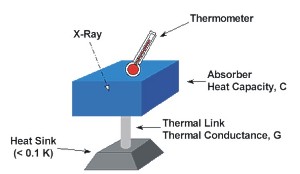X-ray Microcalorimeter


Microcalorimeters offer a promising technology for high throughput, high
resolution X-ray spectroscopy. A microcalorimeter is, in essence, an
ultra sensitive
thermometer. It measures the energy of each
incident X-ray photon by sensing a tiny increase in temperature of the
absorber and then converts the temperature pulse to a measurable
electrical pulse, typically by making use of the fact that its electrical
resistance of a microcalorimeter is a strong function of temperature.
It recovers and is ready for the next X-ray photon, when the heat generated
leaks from the absorber to the heat bath of constant temperature; the
more quickly the leakage occurs the faster the pulse decays. The accuracy
to which a microcalorimeter measures the photon energy is fundamentally
limited by thermodynamic fluctuations in the exchange of thermal energy
between the absorber and the heat bath, which is proportional to the
temperature squared and also to heat capacity. To
achieve good spectral resolution, therefore, it is necessary to operate
the microcalorimeter at cryogenic temperatures (typically < 100 mK).
I particpated in
the development of semiconductor-based X-ray calorimeters and, subsequently,
in the successful demonstration of operating such devices as excellent X-ray
spectrometers in space in sounding rockets flights, as a graduate student at UW-Madison. Those devices
are made of heavily dopped silicon.
At sufficiently low temperatues, they conduct electricity via a
"hopping" mechanism, with their electrical resistance being a strong function
of
temperature. They possess far superior energy resolution compared to the CCDs
that have been used as the primary spectrometer in X-ray astronomy, and also
have much higher quantum efficiency than state-of-the art gratings (e.g.,
those employed by the Chandra X-ray Observatory and XMM-Newton Observatory).
Efforts have been made to employ microcalorimeters in a major satellite
mission but, unfortunately, none has been successful for reasons unrelated
to the devices themselves.
We are now developing superconductor-based microcalorimeters, commonly known
as transition-edge sensor (TES). A conventional superconductor behaves like
a normal electrical conductor at high temperatures. But, when the temperature
drops below some characteristic value (which depends on material), its
electrical resistance vanishes, i.e., it becomes a perfect conductor with
zero electrical resistance. The transition between the normal and
superconducting states can occur over a very narrow temperature range. Now
imagine, a TES is operated at the edge of the transition. Its electrical
resistance is extremely sensitive to temperature variation, which makes it
superior to any semiconductor-based microcalorimeter, in principle. The TES
technology has other advantages too. For instance, standard micro- and
nano-fabrication techniques are used to produce TES devices, so it is easier
to produce a large array of sensors with good uniformity. The focus of our
work is to produce an array of TES
detectors with fairly large pixels (~0.5 mm in size), optimized to deliver
good energy resolution (2 eV @ 0.6 keV) at soft energies (0.1 to ~1 keV).